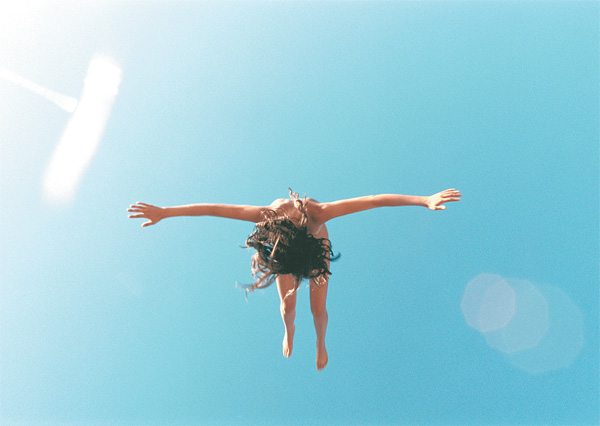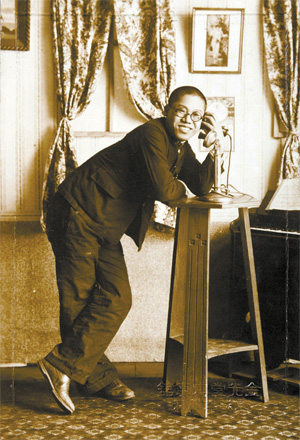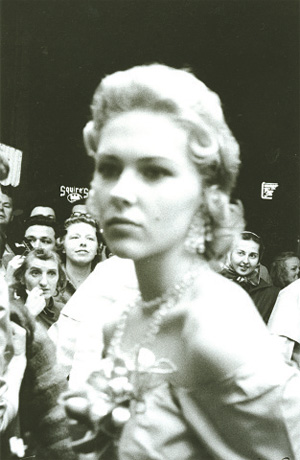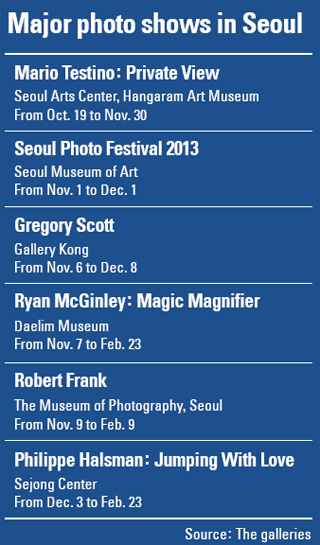Photo portraits put face on history, freedom, hope

“Falling & Flare” (2008) by Ryan McGinley

“A Boy Posing As If He Were Having a Phone Call,” by Geumgwangdang Photo Studio in Seoul in the 1920s
The third edition of the annual Seoul Photo Festival, hosted by the city government, has the title “Portraits of Our Time: 1883-2013.” It indicates that the festival’s exhibits are intended to look back on the modern history of Seoul and Korea through portrait photos of its people.
The festival’s main exhibitions are divided into two parts: Part one is “Portraits in Modern Era,” and Part two is “Portraits Today.”
Part one starts with portrait photos juxtaposed with portrait paintings depicting the same models. They show how the main method of portrait has changed since Kim Yong-won, a pioneer of photography in Korea, opened the country’s first photo studio in central Seoul in 1883.
The exhibits include not only typical portrait photos taken in studios in the 1920s and 1930s, but also photos for anthropological research and rogues’ galleries, including Korean independence activists under Japanese colonial rule.
Part two includes typical portraits of models or celebrities for magazine covers in the period of fast economic growth as well as portraits of ordinary people by photojournalists and fine-art photographers.
The festival also includes special exhibitions; “Bukchon and the People” and “Marriage Stories of Seoul Citizens.” There are also educational programs, including lectures by professionals.
The festival is held until Dec. 1 at the Seoul Museum of Art. Admission is free. Hours are 10 a.m. to 8 p.m. The closing time is shortened to 6 p.m. on weekends. It is closed on Mondays.
Go to Seoul City Hall Station, line No. 2, exit 10 and walk five minutes. For details, visit www.seoulphotofestival.com/2013 or call (070) 8240-9902.

“Movie Premiere” (1955-6) by Robert Frank
Magic Magnifier
The solo show of popular American photographer Ryan McGinley features photos of young people freely running, jumping or dancing, often in open, colorful landscapes. Most of them are in the nude, but their bodies in motion carry a sense of primitive freedom rather than eroticism.
“Activity is a very important element in my photography,” McGinley, 36, said in Seoul earlier this month. “And the biggest reason why I take pictures of young people is their rebellion and, most of all, freedom.”
The models are mainly his fellow downtown artists. McGinley rose to fame in his 20s with such “young and beautiful” photos and became one of the youngest artists to have a solo show at the Whitney Museum of American Art in New York.
The exhibition runs through Feb. 23 at Daelim Museum.
Admission is 5,000 won ($4.74) for adults. Hours are 10 a.m. to 6 p.m. The museum is closed on Mondays.
Go to Gyeongbokgung Station, line No. 3, exit 3 or 4, and walk for five minutes. For details, visit www.daelimmuseum.org or call (02) 720-0667

“Marilyn Monroe”(1959) by Philippe Halsman. Provided by the exhibition organizers
Jumping With Love
Philippe Halsman (1906-79), was a renowned Latvian-born American portrait photographer whose pictures appeared on the cover of 101 issues of Life magazine. He sought to convey messages of hope and courage with jumping shots of his models.
According to the organizers, when he was falsely accused of his father’s death and imprisoned for more than four years, he started thinking about the difference between truth and that which appears to be the truth. When he became a portrait photographer, Halsman decided to show the true nature of people and developed a philosophy of “jump photography” in which he asked his models to jump. The models included Marilyn Monroe, Audrey Hepburn and former U.S. President Richard Nixon. His photos transcended the inner soul of people and created a psychology portrait genre.

In the “Jumping With Love” exhibition, more than 200 of Halsman’s works are presented for the first time in Korea, along with the props of some of the celebrities in his photos. Also included in the exhibition are some Korean celebrities, including figure skating queen Kim Yu-na, female weightlifter Jang Mi-ran and actor Ahn Seong-gi.
The show is being held at the Sejong Center for the Performing Arts from Dec. 3 to Feb. 23. Admission is 12,000 won for adults. Hours are from 11 a.m. to 8:30 p.m. Go to Gwanghwamun Station, line No. 5, exit 1.
For details, call (02) 532-4407 or visit www.jumpingwithlove.co.kr.
By Moon So-young AND Baek Hee-youn [symoon@joongang.co.kr]










with the Korea JoongAng Daily
To write comments, please log in to one of the accounts.
Standards Board Policy (0/250자)